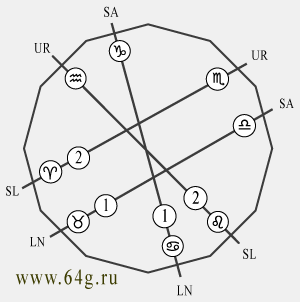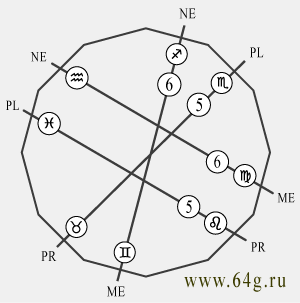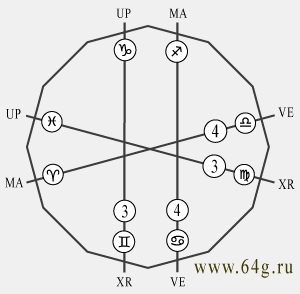-
-
Some zodiacal positions of exalted planets in diagrams and tables on
the previous page correspond to traditional rules of classical astrology.
In particular zodiacal positions of the Sun in Aries, Uranus in Scorpio,
Moon in Taurus, Saturn in Libra, Neptune in Aquarius, Mercury in Virgo
correspond to rules of classical astrology in teaching programs of
various schools and academies.
But zodiacal positions of the Proserpine in Leo, Pluto in Pisces, Venus
in Cancer, Mars in Sagittarius, Jupiter in Capricorn are new for
contemporary astrology.
But these new positions are proved as correspond to geometrical
algorithms which in the space of astrological circle form polygonal
figure of hexagonal or six-pointed star, according to which heavenly
bodies of planets exalt in signs of zodiac, that is shown on charts or diagrams.
 |
First diagram shows geometric algorithms of zodiacal
domination and exaltation for planets of 1st and 2d axes. According to first axis. Dominating Moon from Cancer moves 60 degrees and becomes as exalted in Taurus. Dominating Saturn from Capricorn shifts by 90 degrees and becomes as exalted in Libra. According to second axis. Dominating Sun from Leo displaces at 120 degrees and displays as exalted in Aries. Dominating Uranus from Aquarius moves 90 degrees and displays as exalted in Scorpio. These zodiacal positions of exalting planets correspond to traditional rules of classical astrology, and consequently this geometrical algorithm is taken as basic for displacement of other axes. |
 |
Second diagram shows geometric algorithms of zodiacal
domination and exaltation for astrological planets of 5th and 6th axes. According to fifth axis. Dominating Pluto from Scorpio shifts by 120 degrees and displays as exalted in Pisces. Dominating Proserpine from Taurus displaces at 90 degrees and becomes as exalted in Leo. According to sixth axis. Dominating Neptune from Sagittarius moves 60 degrees and displays as exalted in Aquarius. Dominating Mercury from Gemini shifts by 90 degrees and becomes as exalted in Virgo. This geometrical algorithm is similar, or in other words is congruent to displacement of astrological planets of first and second axes. Difference consists that axes are displaced in clockwise and counter-clockwise directions on the first and second diagrams. |
 |
Third diagram shows geometrical algorithms of zodiacal
domination and exaltation for heavenly bodies of astrological planets of 3rd and 4th axes. According to third axis. Dominating Jupiter from Pisces moves 60 degrees and displays as exalted in Capricorn. Dominating Chiron from Virgo displaces at 90 degrees and becomes as exalted in Gemini. According to fourth axis. Dominating Mars from Aries shifts by 120 degrees and becomes as exalted in Sagittarius. Dominating Venus from Libra displaces at 90 degrees and displays as exalted in Cancer. This geometrical algorithm also is congruent to zodiacal displacement of first and second planetary axes. Displacement in this case is clockwise. |
Altogether, according to the shown algorithms in each sign of zodiac there
are eight key or basic planets which form fundamental basis of human personality.
Dominant planet or day-time male operator has the greatest force of 10 points.
Co-dominant planet or night-time female operator has force of 9 points.
Pay attention that Neptune is considered as day-time operator in zodiacal
sign Sagittarius, and Jupiter in Pisces, during formation of geometrical figure
of hexagonal star. Because Neptune should exalts in Aquarius and cannot be
exalting in Capricorn. But however Neptune is dominant day-time operator in
zodiacal sign Pisces, and Jupiter in Sagittarius.
Anti-dominant planet in opposition to day-time operator has the least
force of 1 point.
Co-anti-dominant planet in opposition to night-time operator has force of 2 points.
In some cases anti-dominant and co-anti-dominant planets in signs of zodiac
are absent, if there are no night-time operators.
Exalted planet or exalting operator has force of 8 points.
Co-exalted planet on one axis with exalting operator in geometrical
figure of hexagonal star has force of 7 points.
For example, in the zodiacal sign Scorpio there are exaltation of Uranus and
co-exaltation of Sun, as these planets are on one axis in geometrical figure of
hexagonal star.
In some cases co-exalting planets in signs of zodiac are absent.
Anti-exalted planet in opposition to exalting operator has force of 3 points.
Co-anti-exalted planet on one axis with anti-exalting associate has force
of 4 points.
For example, in the zodiacal sign Scorpio there are anti-exaltation of Moon and
co-anti-exaltation of Saturn, as these planets are on one axis in geometrical
figure of hexagonal star.
In some cases co-anti -exalting planets in zodiacal signs are absent.
Following page shows information about geometrical algorithms of planets or
diagrams according to which astrological heavenly bodies in signs of zodiac are
relevant and irrelevant.
Also about obvious and implicit displays of astrological
planets in zodiacal signs.
-
Also on nine pages in this section of website you may look information about tables of planetary points and ecliptic course of heavenly bodies, mental reactions of personality and hierarchies of mythological gods, divine image of universe and symbol of mountain Zion, zodiacal signs and natural elements, classical astrology and modern astrologers.